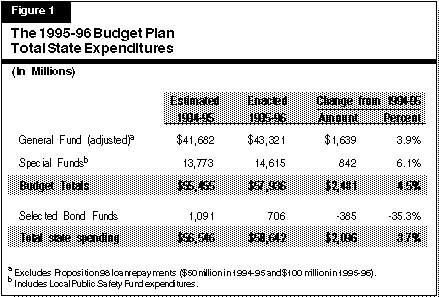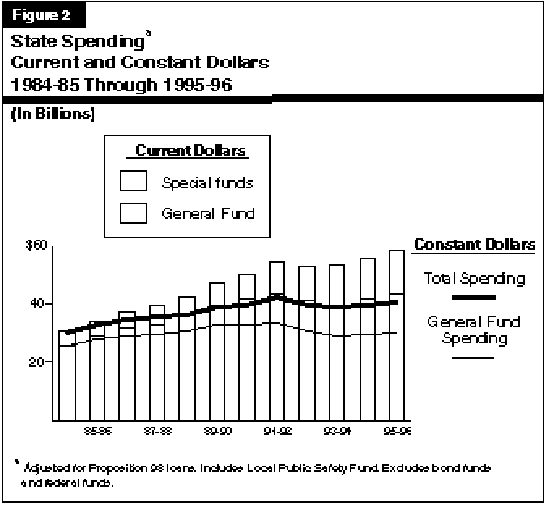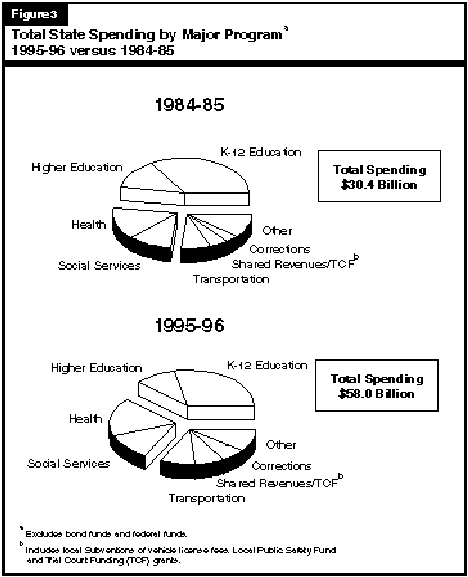Chapter 1
The 1995-96 Budget Package
In this chapter, we discuss the 1995-96 budget problem faced by the Legislature and the Governor and the how the budget package addressed that problem.
The 1995-96 Budget Problem
The 1995-96 budget problem grew out of a continuation of the budget problems that had plagued the state as a result of the recession of the early 1990's.
1994-95 Plan Fell Short
In July 1994, when the 1994-95 budget plan was adopted, there existed an accumulated General Fund budget deficit estimated to be about $2 billion. The 1994-95 budget plan was intended to eliminate this accumulated deficit over a two-year period (1994-95 and 1995-96). That budget plan called for paying off $1 billion of the deficit by the end of 1994-95 and eliminating the remaining $1 billion deficit in 1995-96, when the state would end the year with a balanced budget.
By January 1995, however, it became clear that the 1994-95 budget plan would not achieve its goal of a balanced budget in 1995-96. While the estimated 1994-95 year-end deficit had declined to $740 million, General Fund spending was projected to exceed revenues by more than $1.2 billion in 1995-96 absent corrective action. As a result, the state faced a budget deficit that would reach $2 billion by the end of 1995-96.
Federal Funds Assumptions Proved Too Optimistic. The projected $2 billion budget gap was not the result of poor economic performance or unantici pated caseload growth. In fact, revenue growth was outpacing estimates, and caseload growth was moderating slightly. However, the 1994-95 budget plan had relied on the assumption that the state would receive a total of $3.6 billion of new federal funds for immigrant-related costs over the two-year period. By January 1995, federal actions had committed less than $300 million of that amount, and the pros pects for most of the remaining $3.3 billion appeared poor. This massive shortfall in the realization of assumed federal funding overwhelmed the underlying improve ment in budget trends, resulting in the $2 billion budget gap.
Final Budget Gap Fell to $1.3 Billion. By May 1995, when the Governor released his May Revision budget updates, the size of the 1995-96 budget gap facing the state had declined to $1.8 billion, primarily due to slower growth in health and welfare caseloads and prison populations, and to savings from a reestimate of state borrowing expenses. The final budget gap dropped further--to about $1.3 billion--as a result of improved revenue collections late in 1994-95 and downward revisions to the estimated growth of K-12 school enrollment and welfare caseloads in 1995-96.
The Governor's Budget Proposals
Figure 1 outlines the Governor's original January proposal to address the 1995-96 budget gap and his revised budget proposal presented in May. The two proposals were quite similar. Both relied on reductions to welfare and health programs for most of their savings. The bulk of the remaining savings were to come from assumed additional federal funds for immigrant-related costs (although at a more modest level than assumed in the 1994-95 budget package) and from a net state savings resulting from a major realignment of program responsibilities and funding between the state and the counties. Both plans also proposed a major tax reduction, phased in over three years starting with the 1996 tax year. Although both plans resulted in a balanced budget at the end of 1995-96, neither plan provided a significant budget reserve.
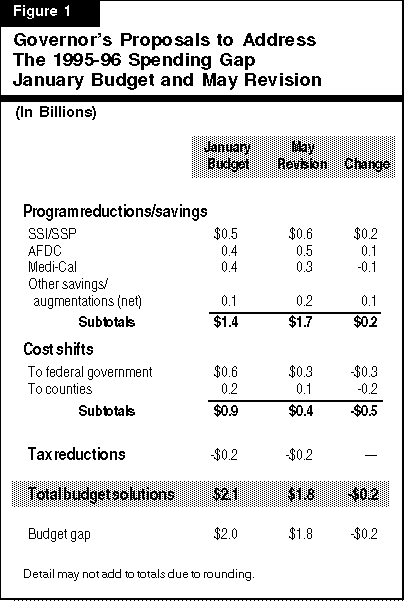
The major changes that occurred in the May Revision were a $500 million reduction in state savings due to a drop in assumed federal funds, and a reduction in program realignment savings. These reduced state savings were offset by the $200 million decrease in the budget gap and about $300 million of additional program reductions (primarily deeper welfare cuts), thereby keeping the budget in balance.
Health and Welfare Reductions
Welfare Grant Reductions. The Governor proposed major reduc tions and limitations to welfare grants. Grants provided under Aid to Families with Dependent Children (AFDC) would be reduced by 7.7 percent, with an additional 15 percent cut after six months on aid. Grants provided under the SSI/SSP program (which serves low-income elderly, blind, and disabled persons) were proposed to be reduced by 11.5 percent for individuals and 13.5 percent for couples in the May Revision. The Governor also proposed a two-year time limit on AFDC grants and certain eligibility restrictions for AFDC and SSI/SSP grants. These welfare reductions accounted for a total savings of $1.1 billion in the May Revision. In addition to approval by the Legislature, almost all of these savings required either federal law changes or administrative waivers.Medi-Cal Reductions. The Governor proposed more than $300 million of savings in health services provided to low-income persons under the Medi-Cal program. The bulk of the savings were to come from eliminating nine optional (not federally required) services, such as adult dental care, and from eliminating prenatal services for undocumented immigrant women.
Federal Funds
The January Budget assumed that the federal government would provide almost $600 million of new funding to the state in 1995-96 (beyond the $245 million already authorized) for costs associated with illegal immigrants and refugees. Most of this funding was to cover the full state cost for Medi-Cal health services to illegal immigrants and for the incarceration of illegal immigrant felons. The May Revision reduced the amount of Medi-Cal funding (based on the President's budget proposal) and eliminated the refugee funding, bringing the amount of new federal immigrant funding assumed in the budget down to $273 million.
State/County Program Realignment
The January budget proposed to shift to the counties $1.9 billion of state costs for AFDC grants, foster care and child welfare services. Most of these costs were proposed to be offset by shifting a total of $1.6 billion in state resources to the counties via increased trial court funding and subventions of sales tax revenue. The proposal resulted in a net state savings (and equivalent net cost to counties) of $241 million in 1995-96. The May Revision increased funding to the counties and reduced the net state savings to $75 million.
Tax Reduction Proposal
The January and May budget proposals both included the Governor's tax reduction proposal. That proposal would have continued the existing temporary high-income tax brackets, scheduled to sunset in 1996, but would have phased-in over three years a 15 percent reduction in all individual and business income tax rates. The May Revision estimated the net revenue reduction from the proposal in 1995-96 at $179 million, with much larger impacts in subsequent years.
The Trigger and Proposition 98 Loan Repayments
Based on the May Revision budget proposal, the Department of Finance esti mated that the state would end 1995-96 with a cash "cushion" of about $1.8 billion of unused borrowable special fund balances. This cushion would avoid the need to make across-the-board spending reductions under last year's "trigger" legislation, which requires action to prevent any projected year-end cash shortfall.
Cash Cushion Included Loan Repayments. Budgeted Proposi tion 98 loan repayments provided $706 million of the $1.8 billion cash cushion. These loans had been provided as off-budget spending to schools and community colleges in 1992-93 and 1993-94 and were to be repaid as cash offsets against their future Proposition 98 entitlements from the state under a statutory formula. Consequently, the proposed loan repayments would result in the state spending $706 million less on a cash basis than the amount of budgeted Proposition 98 spending. The education community contended that the loans were invalid under Proposition 98 and that there should not be any cash deductions from their state entitlements, and their position had prevailed in a trial court decision in the CTA v. Gould lawsuit.
The Adopted Budget Package
In addition to the 1995 Budget Act, the 1995-96 budget package includes several related measures enacted to carry out the budget agreement. Figure 2 lists these budget "trailer bills."
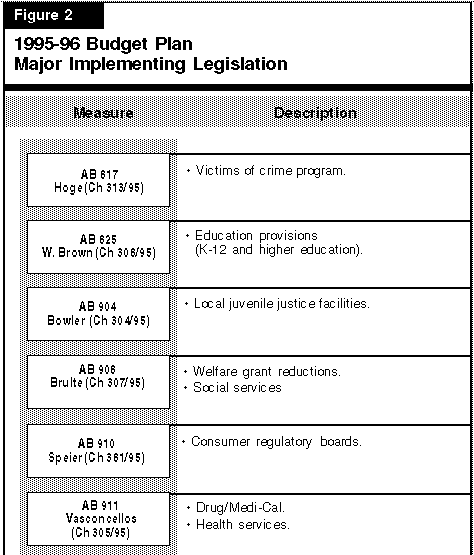
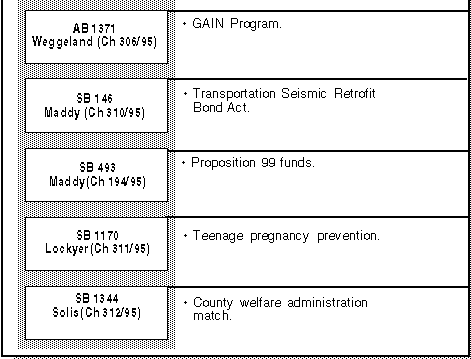
Differences from May Revision. The budget package adopted by the Legislature differed from the Governor's May Revision proposal in several major areas, as follows:
- The adopted reductions in welfare grants and health programs generate
roughly half as much savings as the May Revision proposals.
- The adopted budget did not include the Governor's proposed tax reduction, nor
did it extend the temporary high-income brackets.
- The state/county realignment proposal was not adopted.
- Proposition 98 loan repayments were reduced to $150 million, as part of a tentative settlement of the CTA v. Gould lawsuit agreed to by the Governor. The reduced repayments resulted in increased assistance to schools and community colleges.
Overall, the program reductions and savings in the adopted budget total about $600 million less than the total of the reductions proposed in the May Revision. The difference was made up by the $500 million improvement to the budget gap that was recognized after the May Revision, and by not adopting the tax reduction proposal. The adopted budget ends 1995-96 in balance, but, like the Governor's May Revision proposal, without a meaningful reserve.
Budget Strategy Differs From 1994-95. Figure 3 (next page) identifies the major actions taken to close the final $1.3 billion budget gap, together with the Administration's estimates of the fiscal effect of each action. As the figure shows, almost three-fourths of the gap was addressed by program reductions or savings. This approach contrasts with the strategy employed in the 1994-95 budget package, which relied primarily on cost shifts to the federal government and counties, and on cost deferrals (including a planned carryover deficit) to resolve a much larger $4.5 billion budget gap.
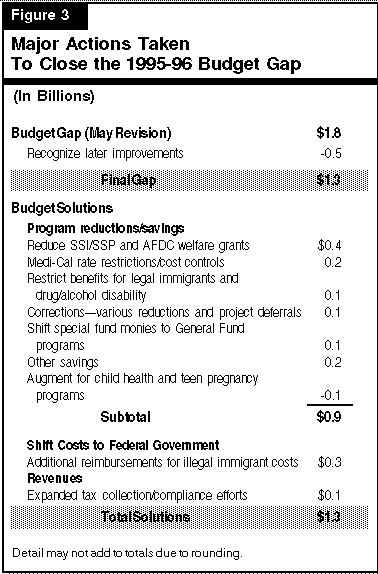
Summary of Actions Taken To Close the Budget Gap
In brief, the major actions taken to close the 1995-96 budget gap consisted of the following:
- Program Reductions/Savings--$0.9 Billion. Reductions to welfare grants in the AFDC and the SSI/SSP programs provide the largest amount of savings. The budget package reduces grants by 4.9 percent statewide and by an additional 4.9 percent in low-cost counties (as measured by rental housing costs). A variety of Medi-Cal rate restrictions and cost controls for dental, long-term care and hospital services provide the second largest amount of savings. The budget also achieves savings by restricting eligibility for health and welfare benefits to legal immigrants who have sponsors and to persons with drug or alcohol dependencies.
- Shift to Federal Government--$0.3 Billion. The budget relies
on cost shifts to the federal government to address more than $300 million of the
budget gap. The bulk of this savings is from assumed additional funding for the
incarceration costs of illegal immigrant felons and for the cost of emergency Medi-Cal
services to undocumented persons.
- Revenue Collection and Compliance--$0.1 Billion. The budget assumes enactment of federal legislation to collect delinquent state taxes from federal tax refunds and includes additional revenues from enhanced audit and collection activities by the state's tax agencies.
Increased Funding For Education and Corrections
K-12 Education. Per-pupil spending will increase by more than $200 from the level provided in the 1994-95 budget package. A portion of this funding increase is due to the expenditure of more than $550 million that had been proposed as loan repayment offsets by the Governor. Instead, schools will receive this money (although $360 million will not be made available until next summer, pending final settlement of the CTA v. Gould lawsuit).
Higher Education. State General Fund support for UC and CSU increases modestly (by 4.9 percent and 1.5 percent, respectively). General Fund support for community colleges increases by almost 10 percent, but overall funding grows by less than 4 percent due to stagnant property tax growth. The budget package does not include any undergraduate student fee increases.
Corrections. Spending for correctional programs grows by 8.6 percent in 1995-96 (including budgeted federal funds for immigrant costs).
No Trigger "Pull" Anticipated by Budget Plan
The administration estimates that the adopted budget package will enable the state to end 1995-96 with about $1.9 billion of unused borrowable special fund balances. Under last year's trigger legislation, this cash cushion would avoid the need to make across-the-board cuts or to borrow across fiscal years from external sources. The official determination of the state's projected cash position for trigger purposes will be made by the State Controller on October 15.
Chapter 3 of this report more fully discusses the significant elements of the budget package as they relate to major program areas.
Budget Plan's Projected General Fund Condition
Figure 4 shows the General Fund condition for 1994-95 and 1995-96 as estimated by the Department of Finance, based on the 1995-96 budget package.
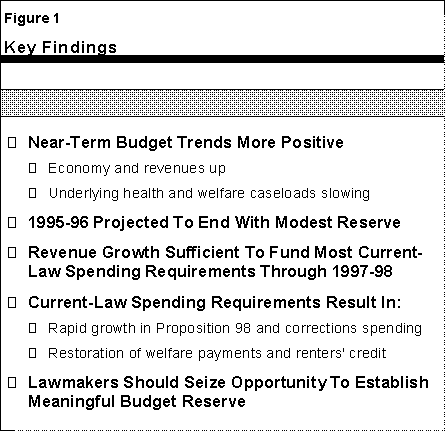
The General Fund ended 1994-95 with an estimated deficit of $629 million. Under the budget package, this deficit will be eliminated in 1995-96. Budgeted spending from the General Fund for 1995-96 is $43.4 billion--an increase of 4 percent from 1994-95.
Modest Revenue Growth Assumed. General Fund revenues are projected to be $44.1 billion in 1995-96, an increase of $1.5 billion, or 3.5 percent, over 1994-95. This includes an increase of $1.5 billion (8.1 percent) in personal income taxes and $877 million (6 percent) in sales and use taxes, partially offset by a reduc tion of $816 million in bank and corporation taxes. The bank and corporation tax decline is attributable primarily to two factors--a large one-time gain realized in 1994-95 from a court decision involving the state's taxation of multinational corpora tions, and the phasing in of investment tax credit legislation enacted in 1994. In the absence of these factors, total 1995-96 revenue growth would be more in the range of 6 percent, reflecting moderate economic expansion. Figure 5 shows, for example, that employment is projected to rise moderately through 1995 and through 1996. It is projected to surpass its pre-recession peak by the end of 1996.
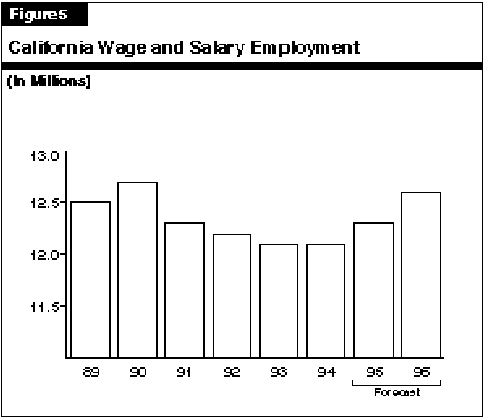
Budget Relies on Federal Actions
The budget relies on federal actions to achieve almost $800 million of savings. Figure 6 lists these budget proposals. In addition to increased funding for immigrant costs, almost all of the savings from welfare grant reductions and eligibility restric tions require either federal legislation or a federal administrative waiver. Further more, in addition to the $800 million of budgeted savings from new federal actions, $245 million currently authorized for the incarceration of illegal immigrant felons remains contingent on final federal budget actions. Consequently, the success of the state's 1995-96 budget plan depends to a large extent on the actions of Congress and the Clinton administration.
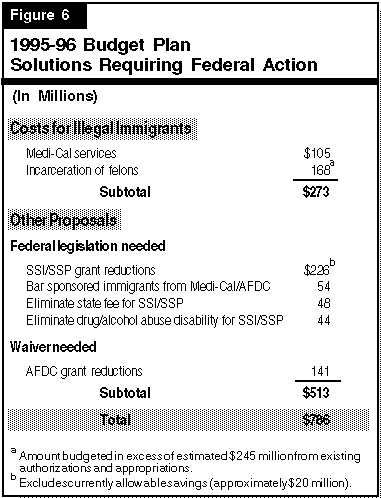
Additional Factors Could Affect the Budget Outlook
In addition to the federal actions discussed above, a number of other potential developments could affect the budget outlook in 1995-96. Revenue collections, as always, are subject to economic developments, and uncertainties in the current economic outlook provide both potential upside and downside risks. In addition, developments that will bear watching include the following:
- Welfare Reform. Congress currently is completing
action on a major welfare reform proposal, which would convert AFDC to a block
grant. Proposals now under consideration would reduce federal funding and allow
states more program flexibility. The initial reduction of federal funds would be
relatively small in 1995-96 but could be several hundred million dollars annually
starting in 1996-97.
- PERS v. Wilson. A trial court has found in favor of PERS'
contention that the state illegally deferred its retirement contributions for employees
for several years. If the decision is affirmed on appeal, the potential cost to the state
could be more than $1 billion.
- Federal Audit Exception. The state is persuing an administrative
appeal of a federal audit exception which would require the state to share with the
federal government some of its past savings from the use of excess employee
retirement funds. The amount at stake is more than $100 million.
- Property Tax Revenues to Schools. Any shortfall in property tax
revenues to schools and community colleges would require an offsetting increase in
state aid under Proposition 98. Preliminary information indicates that there may have
been a shortfall in final 1994-95 property tax receipts by schools and community
colleges. A property tax shortfall of one percent would be equivalent to about one
hundred million dollars.
- Use of Proposition 99 Funds. The budget's use of about $61
million of Proposition 99 tobacco tax funds to help finance certain health programs
has been enjoined as the result of a lawsuit. This action could result in budget
pressure to replace at least a portion of the affected funding.
- Social Services Savings. On the positive side, the Department of Social Services reports that its final spending for local assistance in 1994-95 was about $46 million less than estimated in the budget package, in part due to somewhat slower caseload growth.
 Legislative
Analyst's Office, September 1995
Legislative
Analyst's Office, September 1995
